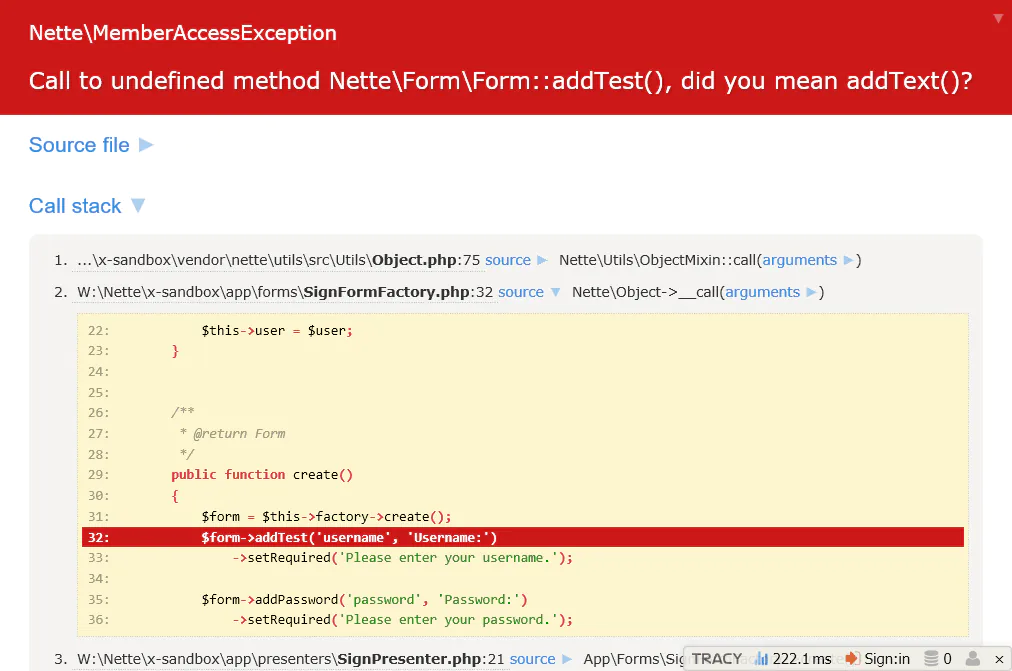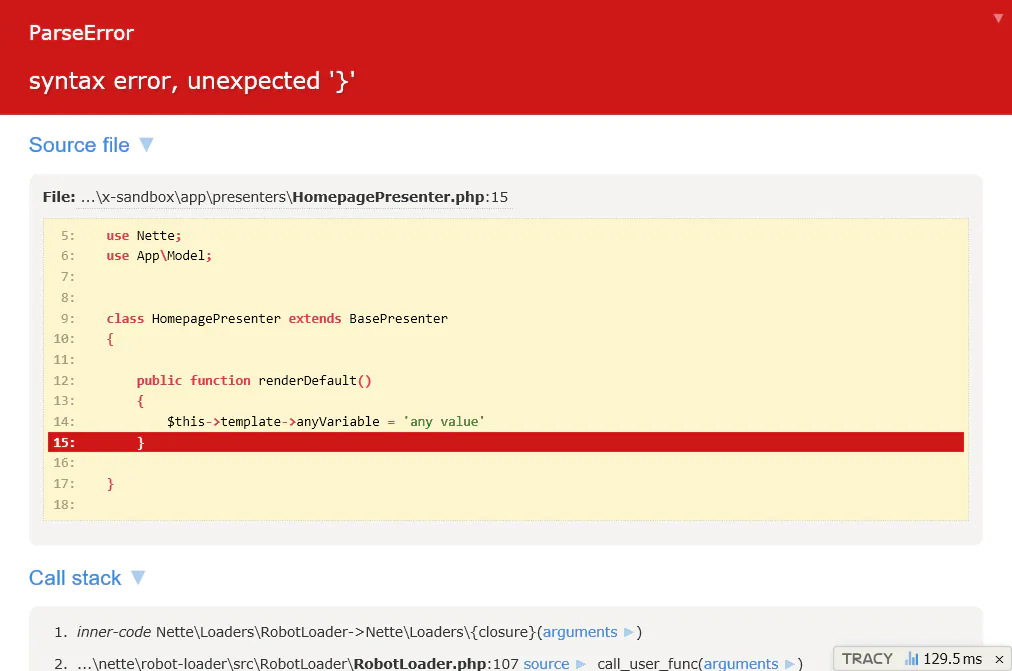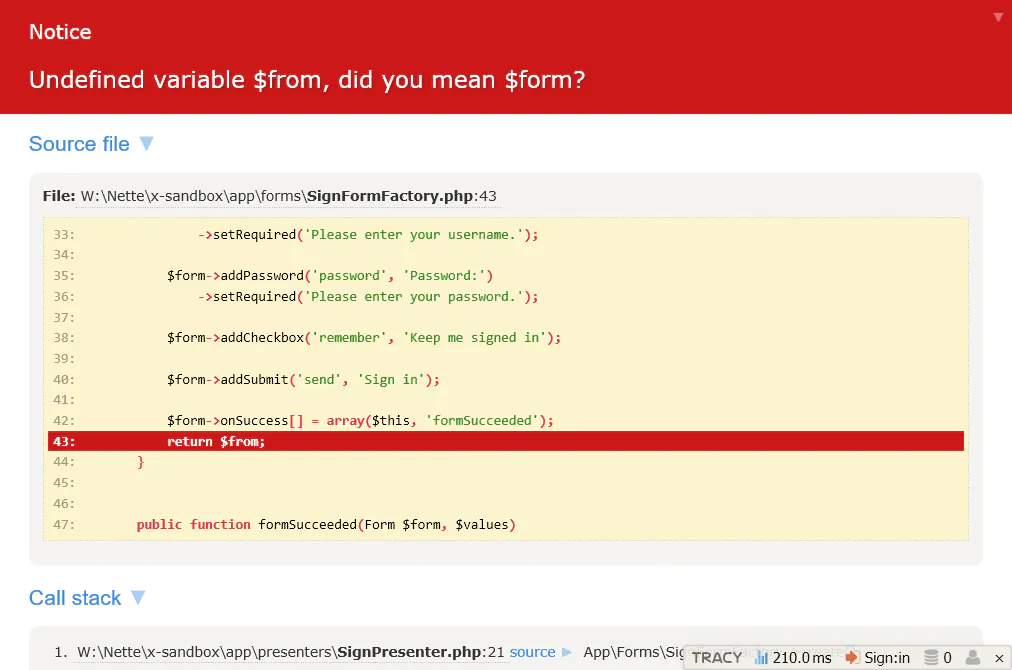Getting Started with Tracy
The Tracy library is a useful everyday helper for PHP programmers. It helps you to:
- quickly detect and correct errors
- log errors
- dump variables
- measure execution time of scripts/queries
- see memory consumption
PHP is a language perfectly suited for creating hard-to-detect errors, as it gives developers considerable freedom. This makes a debugging tool like Tracy all the more valuable. It represents the absolute pinnacle among diagnostic tools for PHP.
If you're encountering Tracy for the first time today, believe that your life will start to be divided into the time before Tracy and the time with her. Welcome to the better part!
Installation
The best way to install Tracy is to download the latest package or use Composer:
composer require tracy/tracy
Alternatively, you can download the whole package or the tracy.phar file.
Usage
Tracy is activated by calling the Tracy\Debugger::enable() method as soon as possible at the beginning of the
program, before any output is sent:
use Tracy\Debugger;
require 'vendor/autoload.php'; // alternatively tracy.phar
Debugger::enable();
The first thing you'll notice on the page is the Tracy Bar in the bottom right corner. If you don't see it, it may mean that
Tracy is running in production mode. This is because Tracy is only visible on localhost for security reasons. To test if it works,
you can temporarily put it into development mode using the Debugger::enable(Debugger::Development) parameter.
Tracy Bar
The Tracy Bar is a floating panel displayed in the bottom right corner of the page. You can move it with the mouse, and it will remember its position after the page reloads.

You can add other useful panels to the Tracy Bar. You can find interesting ones in addons or you can create your own.
If you do not want to show the Tracy Bar, set:
Debugger::$showBar = false;
Visualization of Errors and Exceptions
You surely know how PHP reports errors: it prints something like this into the page's source code:
Parse error: syntax error, unexpected '}' in HomePresenter.php on line 15
or an uncaught exception:
Fatal error: Uncaught Nette\MemberAccessException: Call to undefined method Nette\Application\UI\Form::addTest()? in /sandbox/vendor/nette/utils/src/Utils/ObjectMixin.php:100
Stack trace:
#0 /sandbox/vendor/nette/utils/src/Utils/Object.php(75): Nette\Utils\ObjectMixin::call(Object(Nette\Application\UI\Form), 'addTest', Array)
#1 /sandbox/app/Forms/SignFormFactory.php(32): Nette\Object->__call('addTest', Array)
#2 /sandbox/app/Presentation/Sign/SignPresenter.php(21): App\Forms\SignFormFactory->create()
#3 /sandbox/vendor/nette/component-model/src/ComponentModel/Container.php(181): App\Presentation\Sign\SignPresenter->createComponentSignInForm('signInForm')
#4 /sandbox/vendor/nette/component-model/src/ComponentModel/Container.php(139): Nette\ComponentModel\Container->createComponent('signInForm')
#5 /sandbox/temp/cache/latte/15206b353f351f6bfca2c36cc.php(17): Nette\ComponentModel\Co in /sandbox/vendor/nette/utils/src/Utils/ObjectMixin.php on line 100
Navigating such output isn't exactly easy. If you enable Tracy, errors and exceptions are displayed in a completely different form:

The error message literally screams. You can see the part of the source code with the highlighted line where the error occurred. The message Call to undefined method Nette\Http\User::isLogedIn() clearly explains the error. The entire page is interactive; you can click through for more details. Try it.
And guess what? Fatal errors are captured and displayed in the same way. Without needing to install any extensions.

Errors like a typo in a variable name or an attempt to open a non-existent file generate reports at the E_NOTICE or E_WARNING level. These can be easily overlooked within the page's graphical layout, or even be completely invisible (unless you look at the source code). Let Tracy manage them:

Or they can be displayed like errors:
Debugger::$strictMode = true; // display all errors
Debugger::$strictMode = E_ALL & ~E_DEPRECATED & ~E_USER_DEPRECATED; // all errors except deprecated notices

Note: Tracy, when activated, changes the error reporting level to E_ALL. If you want to change this, do so after calling
enable().
Development vs Production Mode
As you can see, Tracy is quite talkative, which can be appreciated in the development environment, while on the production server it would cause a disaster. That's because no debugging information should be displayed there. Tracy therefore has environment auto-detection. If the example is run on a live server, the error will be logged instead of displayed, and the visitor will only see a user-friendly message:

Production mode suppresses the display of all debugging information sent out using dump(), and of course also all error messages generated by PHP. So if you have
forgotten some dump($obj) in the code, you don't have to worry, nothing will be displayed on the production
server.
How does mode auto-detection work? The mode is development if the application is running on localhost (i.e., IP address
127.0.0.1 or ::1) and there is no proxy (i.e., its HTTP header is not present). Otherwise, it runs in
production mode.
If you want to enable development mode in other cases, for example for developers accessing from a specific IP address, you can
specify it as a parameter of the enable() method:
Debugger::enable('23.75.345.200'); // you can also provide an array of IP addresses
We definitely recommend combining the IP address with a cookie. Store a secret token, e.g., secret1234, in the
tracy-debug cookie, and in this way, activate the development mode only for developers accessing from a specific IP
address who have the mentioned token in the cookie:
Debugger::enable('secret1234@23.75.345.200');
You can also directly set the development/production mode using the Debugger::Development or
Debugger::Production constants as a parameter of the enable() method.
If you use the Nette Framework, take a look at how to set the mode for it, and it will then also be used for Tracy.
Error Logging
In production mode, Tracy automatically logs all errors and caught exceptions to a text log. For logging to work, you need to
set the absolute path to the log directory in the $logDirectory variable or pass it as the second parameter to the
enable() method:
Debugger::$logDirectory = __DIR__ . '/log';
Error logging is extremely useful. Imagine that all users of your application are actually beta testers who do top-notch work in finding errors for free, and you would be foolish to throw their valuable reports away unnoticed into the trash bin.
If you need to log your own messages or caught exceptions, use the log() method:
Debugger::log('Unexpected error'); // text message
try {
criticalOperation();
} catch (Exception $e) {
Debugger::log($e); // log exception
// or
Debugger::log($e, Debugger::ERROR); // also sends an email notification
}
If you want Tracy to log PHP errors like E_NOTICE or E_WARNING with detailed information (HTML
report), set Debugger::$logSeverity:
Debugger::$logSeverity = E_NOTICE | E_WARNING;
For a true professional, the error log is a key source of information, and they want to be informed immediately about every new
error. Tracy accommodates this by being able to send email notifications for new log entries. The $email variable
determines where to send these emails:
Debugger::$email = 'admin@example.com';
If you use the entire Nette Framework, you can set this and others in the configuration file.
To protect your e-mail box from being flooded, Tracy sends only one message and creates a file email-sent.
When a developer receives the e-mail notification, they check the log, correct the application, and delete the
email-sent monitoring file. This reactivates the e-mail sending.
Opening Files in the Editor
When the error page is displayed, you can click on file names and they will open in your editor with the cursor on the
corresponding line. Files can also be created (action create file) or bugs fixed in them (action
fix it). In order to do this, you need to configure the
browser and the system.
Supported PHP Versions
| Tracy | Compatible with PHP |
|---|---|
| Tracy 2.10 – 3.0 | PHP 8.0 – 8.4 |
| Tracy 2.9 | PHP 7.2 – 8.2 |
| Tracy 2.8 | PHP 7.2 – 8.1 |
| Tracy 2.6 – 2.7 | PHP 7.1 – 8.0 |
| Tracy 2.5 | PHP 5.4 – 7.4 |
| Tracy 2.4 | PHP 5.4 – 7.2 |
Applies to the latest patch versions.
Ports
This is a list of unofficial ports to other frameworks and CMS:
- Drupal 7
- Laravel framework: recca0120/laravel-tracy, whipsterCZ/laravel-tracy
- OpenCart
- ProcessWire CMS/CMF
- Slim Framework
- Symfony framework: kutny/tracy-bundle, VasekPurchart/Tracy-Blue-Screen-Bundle
- WordPress